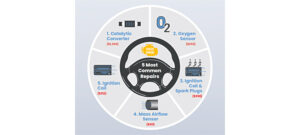Over the past 10 years, the age of aftermarket vehicles has increased nearly 50 percent more than the age of all cars and light trucks in operation
Fort Wayne, Ind.—Aftermarket vehicles — cars and light trucks that are four years and older — represent approximately 80 percent of total light vehicles in operation (VIO), but they generate more than 96 percent of aftermarket product and service volume (not including accessories and tires).
“Changing new vehicle sales and the impact of COVID-19 have combined to create substantial changes in the population growth, nameplate mix, and average age of aftermarket vehicles on U.S. roads,” said Jim Lang in the recently released “2022 Lang Aftermarket Annual” report. “This will help to boost aftermarket product volume in the coming years.”
Vehicle Age Groups Are Not Equal in Aftermarket Sales
While aftermarket vehicles generate more than 96 percent of total light vehicle aftermarket product and service volume, they represent a smaller share of total light vehicles.
Aftermarket vehicles are significantly different from other cars and light trucks in operation. The differences cover a wide range of automotive factors including the rate of population growth, nameplate mix and average age, among other factors.
Aftermarket vehicles are different from the overall vehicle population, just as the aftermarket is different from the OE market.
Key metrics of aftermarket vehicles demonstrate their disproportionate impact on aftermarket product and service sales and can help people both inside and outside the automotive industry to understand more fully the dynamics of aftermarket growth in the U.S. and how it is being influenced by the changing aftermarket vehicle population.
Aftermarket Vehicle Population Growth
Aftermarket vehicles are increasing at a faster pace than the total vehicle population. More than 21 million aftermarket vehicles were added to the nation’s VIO between 2017 and 2020. This represented an annual increase of 3.0 percent, substantially greater than the 1.8 percent yearly growth of total vehicles in operation.
Aftermarket vehicles will continue to grow faster than the total vehicle population during 2021 and 2022, as new vehicle production (and, therefore, sales) are hampered by component shortages, particularly computer chips.
Aftermarket Vehicle Average Age
The average age of aftermarket vehicles is increasing faster than the age profile of total cars and light trucks, and are more than two years older in average age than all light vehicles on U.S. roads.
This difference in the average age levels of aftermarket vehicles and the total light vehicle population is increasing. Over the past 10 years, the age of aftermarket vehicles has increased nearly 50 percent more than the age of all cars and light trucks in operation.
Lang Marketing expects that the average age of aftermarket vehicles will continue to increase faster than all vehicles on the road during 2021 and for the next several years.
Nameplate Shift
The nameplate mix of aftermarket vehicles today is substantially different from 10 years ago, reflecting the surging new vehicle sale share of foreign nameplates.
Domestic nameplates accounted for nearly two-thirds of cars and light trucks at least four years old in the U.S. during 2010. Foreign nameplates represented approximately half of aftermarket vehicles last year.
Aftermarket Implications
Recognizing the importance of aftermarket vehicles and how they differ in a number of key aspects from the total vehicle population is necessary to develop a fuller understanding how aftermarket sales will develop in the coming years.






Comments are closed.